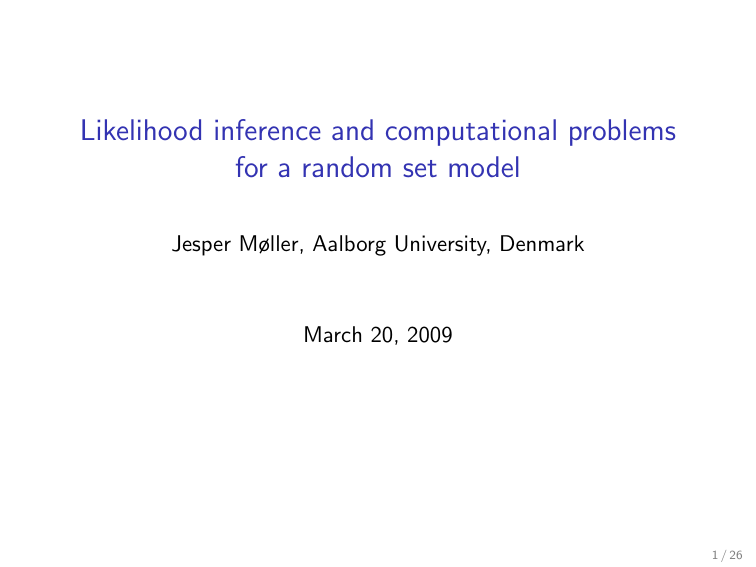Likelihood inference and computational problems for a random set model
advertisement

Likelihood inference and computational problems
for a random set model
Jesper Møller, Aalborg University, Denmark
March 20, 2009
1 / 26
Heather dataset (Diggle, 1981)
Heather plants in a 10 × 20m window W (Jädraås, Sweden).
Grow from seedlings into (roughly) hemispherical bushes ⇒
∪ heather plants “seen from above” = union of discs, UX ,
where X is a disc process.
Observe only UX ∩ W .
2 / 26
UX = germ-grain model:
General germ-grain model:
UX =
[
(ui + Ki )
i
where
I
the germs {ui } ⊂ Rd form a (locally finite) point process,
I
the primary grains Ki ⊂ Rd are random compact sets.
Heather dataset: Ki = b(0, ri ) and
[
UX =
b(ui , ri ).
i
3 / 26
Remarks
I
Theorem: Any random closed set
(i.e., a locally finite union of compact convex random sets)
∼ germ-grain model with convex and compact grains.
I
However,
I
in practice, need a much smaller class of models;
I
often a Poisson disc process (Boolean model).
4 / 26
Poisson disc process
I
{ui } ∼ Poisson point process
I
{ri } IID and independent of {ui }
I
Advantages: well-studied (moment results).
I
Disadvantages/complications:
I
lack of interaction;
I
grains unobservable ⇒ density/likelihood for UX ???
I
MCMC missing data approach, simulating X |UX ∩ W :
not an option: grains only ≈ discs & digital image
⇒ difficult to indentify circular structures.
5 / 26
Fitting a Poisson disc model (Diggle, 1981)
I
Stationary; mark distribution = truncated Weibull.
I
Fitted by a minimum contrast method ? .
I
Simulations: visual impression not good.
I
“A model incorporating interaction may be appropriate”.
?
Further (non-likelihood-based) approaches:
Dupač (1980), Serra (1980), Hall (1985, 1988), Ripley (1988),
Cressie (1993), Stoyan et al. (1995), Molchanov (1997), ...
6 / 26
Our (non-Poisson) model (Møller & Helisova, 2008a,b)
• Pragmatic approach:
a) Specify and fit a Poisson disc process.
b) Extend it to a certain interacting disc process model...
• ... which makes it possible to handle
(1) edge effects;
(2) individual grains are unobservable;
• ... and which provides (the first work on)
simulation-based likelihood inference for a germ-grain model.
7 / 26
Some notation
Identify a finite collection of discs with a marked point pattern
x = {(u1 , r1 ), . . . , (un , rn )} ⊂ S × [0, ∞)
where S ⊃ W is the (unknown!) bounded region for heather plant
centers.
W
S
8 / 26
The density
with respect to reference/fitted Poisson disc process,
fθ (x) =
1
exp (θ1 A(Ux ) + θ2 L(Ux ) + θ3 Ncc (Ux ) + θ4 Nh (Ux ) + . . .)
cθ
where
A = area,
L = perimeter,
Ncc = # connected components,
Nh = # holes.
9 / 26
A connected component Markov process
(Baddeley & Møller, 1989)
fθ (x) =
1
cθ
Y
y ⊆x
φθ (y )
con. comp.
where
φθ (y ) = exp (θ1 A(Uy ) + θ2 L(Uy ) + θ3 + θ4 Nh (Uy ))
10 / 26
Special cases
I
Area-interaction process (with varying radii) if
θ2 = θ3 = θ4 = 0 and θ = θ1 :
1
exp (θA(Ux ))
fθ (x) =
cθ
(Widom & Rowlinson, 1970; Baddeley & Van Lieshout, 1995).
I
Quermass-interaction process if θ3 + θ4 = 0 and
θ = (θ1 , θ2 , θ3 ):
1
fθ (x) =
exp (θ1 A(Ux ) + θ2 L(Ux ) + θ3 χ(Ux )) ,
cθ
(Kendall, Van Lieshout & Baddeley, 1999).
I
χ = Ncc −Nh
Continuum random-cluster model (with varying radii) if
θ1 = θ2 = θ4 = 0 and θ = θ3 :
1
fθ (x) =
exp (θNcc (Ux ))
cθ
(Klein, 1982).
11 / 26
1) Reference Poisson disc process: S = [0, 30] × [0, 30], intensity
= 0.2, IID radii ∼ Uniform[0, 2].
2) (θ1 , θ2 , θ3 , θ4 ) = (0.1, 0, 0, 0).
3) (θ1 , θ2 , θ3 , θ4 ) = (−0.1, 0, 0, 0).
4) (θ1 , θ2 , θ3 , θ4 ) = (0.6, −1, 1, 0).
5) (θ1 , θ2 , θ3 , θ4 ) = (0.6, −1, 2, 0).
6) (θ1 , θ2 , θ3 , θ4 ) = (0.6, −1, 5, 0).
12 / 26
Parameter space
Under mild conditions
fθ (x) =
1
exp (θ1 A(Ux ) + θ2 L(Ux ) + θ3 Ncc (Ux ) + θ4 Nh (Ux ))
cθ
is a regular exponential family model with parameter space
Θ = R4
if the radii are bounded,
or in general
Θ = {(θ1 , θ2 , θ3 , θ4 ) ∈ R4 :
Z
exp πθ1 r 2 + 2πθ2 r ) Q(dr ) < ∞ }
where Q is the mark distribution under the reference Poisson disc
process.
13 / 26
A fundamental characteristic
(Papangelou) conditional intensity:
λθ (x, (u, r )) = fθ (x ∪ {(u, r )})/fθ (x)
for x = {(u1 , r1 ), . . . , (un , rn )} ⊂ S × [0, ∞), (u, r ) ∈ S × [0, ∞).
I
λθ (x, (u, r )) = “local characteristic”;
− log λθ (x, (u, r )) = “local energy”.
I
Important because
I
I
λθ ↔ fθ but λθ does not involve cθ ;
I
specifies local Markov properties;
I
appears in the Hastings ratio of Metropolis-Hastings
birth-death algorithm (Geyer & Møller, 1994; Green, 1995).
In many cases, local stability and hence geometric ergodicity.
14 / 26
Key tool (for many things incl. λθ ): Power tessellation
15 / 26
Book keeping in Metropolis-Hastings birth-death algorithm
(www.math.aau.dk/∼jm/Codes.union.of.discs)
Keep track on (A, L, Ncc , Nh ) by also keeping track on
Nc = # cells,
Nie = # interior edges, Niv = # interior vertices,
and using
A=
X
areas of cells
L=
X
lengths of arcs
Nh = Ncc − Nc + Nie − Niv
16 / 26
Local Markov property
λθ (x, (u, r )) =
exp θ1 A(Ux∪{(u,r )} ) − A(Ux ) + θ2 L(Ux∪{(u,r )} ) − L(Ux ) +
θ3 Ncc (Ux∪{(u,r )} ) − Ncc (Ux ) + θ4 Nh (Ux∪{(u,r )} ) − Nh (Ux )
depends on x only through those Ux -cc which intersect b(u, r ).
If θ3 = θ4 : depends only on those b(ui , ri ) which intersect b(u, r ).
17 / 26
Handle edge effects by exploting a spatial Markov property
Split X into
X (a) (full circles),
X (b) (dashed circles),
X (c) (dotted circles)
W
S
18 / 26
Spatial Markov property
W
S
• X (a) and X (c) are conditionally independent given X (b) = x (b) ;
• X (a) |x (b) ∼ X (a) |V , where V := W ∩ Ux (b) ;
• for feasible x (a) (i.e. Ux (a) ⊆ W and Ux (a) ∩ V = ∅),
fθ (x (a) |V ) =
1
exp (θ1 A(Ux (a) ) + θ2 L(Ux (a) ) + θ3 Ncc (Ux (a) ) + θ4 Nh (Ux (a) )) .
cθ (V )
19 / 26
Heather data: conditional log likelihood
Lc (θ) = log fθ (x (a) |V )
= θ1 A(Ux (a) ) + θ2 L(Ux (a) ) + θ3 Ncc (Ux (a) ) + θ4 Nh (Ux (a) ) − log cθ (V )
with cθ (V ) approximated by MCMC methods.
20 / 26
Unconditional log likelihood
Pretend S = W . Let Y = ∪i b(ui , ri ) ∩ W .
Approximate the log (unconditional) likelihood by ignoring edge
effects,
Lu (θ) = θ1 A(Y ) + θ2 L(Y ) + θ3 Ncc (Y ) + θ4 Nh (Y ) − log cθ
with cθ approximated by MCMC methods.
21 / 26
Some remarks
I
Rather different “conditional” and “unconditional” MLE’s.
I
Preferable(?) to use Lc (θ) (accounts for edge effects);
the effect of using Lu (θ) is less well-understood.
I
Loss of information in using Lc (θ):
A(Y ) = 100.28,
L(Y ) = 382.82,
Ncc (Y ) = 56,
Nh (Y ) = 6,
are about twice as large as
A(Ux (a) ) = 45.6,
L(Ux (a) ) = 190,
Ncc (Ux (a) ) = 32, Nh (Ux (a) ) = 2.
22 / 26
I
Specification of reference Poisson disc process is important.
(We compared results using 3 different reference processes.)
I
But the same overall conclusion (Wald tests; summaries):
θ1 < 0,
θ2 > 0,
θ3 < 0,
θ4 = 0,
so
fθ (x) =
I
1
exp (θ1 A(Ux ) + θ2 L(Ux ) + θ3 Ncc (Ux )) .
cθ
The quermass-interaction process, i.e. θ3 + θ4 = 0 and
fθ (x) =
1
exp (θ1 A(Ux ) + θ2 L(Ux ) + θ3 χ(Ux )) ,
cθ
χ = Ncc −Nh
was rejected.
23 / 26
Some simulations of 3 reference Poisson disc processes
First two: fitted by a method from Hall (1985)
(using a truncated normal and uniform mark dist.).
Third: (partly) taken from Laslett et al. (1985)
Misfit in all 3 cases: too many small components.
Third case: too low area fraction.
24 / 26
Some simulations of 3 fitted (A, L, Ncc )-interaction models
Model control based on various contact distribution functions and
covariance function: no misfit for the two first models.
Shape characteristics: some misfit, possibly since the heather data
are rather smooth while a disc process is naturally more rugged.
25 / 26
References
Møller, J. & Helisova, K. (2008). Power diagrams and interaction
processes for unions of discs. Advances in Applied Probability, 40,
321-347.
Møller, J. & Helisova, K. (2008). Likelihood inference for unions of
interacting discs. Research Report R-2008-18, Department of
Mathematical Sciences, Aalborg University. Submitted.
Software: www.math.aau.dk/∼jm/Codes.union.of.discs
26 / 26


